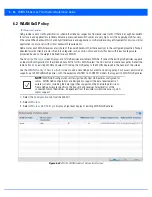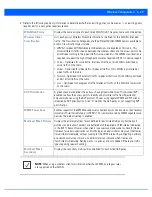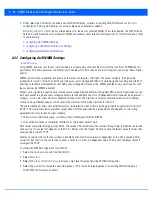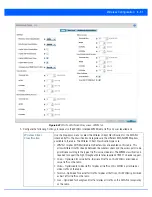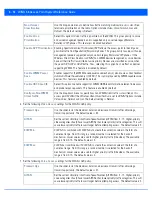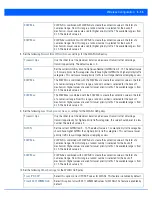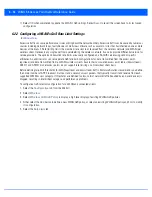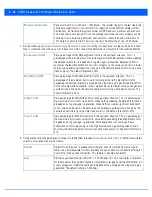
6 - 62 WiNG 5.6 Access Point System Reference Guide
6.3 Radio QoS Policy
Wireless Configuration
Without a dedicated QoS policy, a network operates on a best-effort delivery basis, meaning all traffic has equal priority and
an equal chance of being delivered in a timely manner. When congestion occurs, all traffic has an equal chance of being
dropped!
When configuring a QoS policy for a radio, select specific network traffic, prioritize it, and use congestion-management and
congestion-avoidance techniques to provide deployment customization best suited to each QoS policy’s intended wireless
client base.
Motorola Solutions access point radios and wireless clients support several
Quality of Service
(QoS) techniques enabling real-
time applications (such as voice and video) to co-exist simultaneously with lower priority background applications (such as
Web, E-mail and file transfers). A well designed QoS policy should:
• Classify and mark data traffic to accurately prioritize and segregate it (by access category) throughout the network.
• Minimize the network delay and jitter for latency sensitive traffic.
• Ensure high priority traffic has a better likelihood of delivery in the event of network congestion.
• Prevent the ineffective utilization of access points degrading session quality by configuring admission control mechanisms
within each radio QoS policy.
Within a Motorola Solutions wireless network, wireless clients supporting low and high priority traffic contend with one
another for data resources. The IEEE 802.11e amendment has defined
Enhanced Distributed Channel Access
(EDCA)
mechanisms stating high priority traffic can access the network sooner then lower priority traffic. The EDCA defines four traffic
classes (or access categories); voice (highest), video (next highest), best effort and background (lowest).The EDCA has defined
a time interval for each traffic class, known as the
Transmit Opportunity
(TXOP). The TXOP prevents traffic of a higher priority
from completely dominating the wireless medium, thus ensuring lower priority traffic is still supported by connected radios.
IEEE 802.11e includes an advanced power saving technique called
Unscheduled Automatic Power Save Delivery
(U-APSD) that
provides a mechanism for wireless clients to retrieve packets buffered by an access point. U-APSD reduces the amount of
signaling frames sent from a client to retrieve buffered data from an access point. U-APSD also allows access points to deliver
buffered data frames as
bursts
, without backing-off between data frames. These improvements are useful for voice clients, as
they improve battery life and call quality.
The Wi-Fi alliance has created
Wireless Multimedia
(WMM) and
WMM Power Save
(WMM-PS) certification programs to
ensure interoperability between 802.11e WLAN infrastructure implementations and wireless clients. An access point managed
wireless network supports both WMM and WMM-Power Save techniques. WMM and WMM-PS (U-APSD) are enabled by
default in each WLAN profile.
Enabling WMM support on a WLAN just advertises the WLAN’s WMM capability and radio configuration to wireless clients.
The wireless clients must be also able to support WMM and use the values correctly while accessing WLAN to benefit.
WMM includes advanced parameters (CWMin, CWMax, AIFSN and TXOP) specifying back-off duration and inter-frame spacing
when accessing the network. These parameters are relevant to both connected access point radios and their wireless clients.
Parameters impacting access point transmissions to their clients are controlled using per radio WMM settings, while
parameters used by wireless clients are controlled by a WLAN’s WMM settings.
Access points support static QoS mechanisms per WLAN to provide prioritization of WLAN traffic when legacy (non WMM)
clients are deployed. An access point allows flexible WLAN mapping with a static WMM access control value. When enabled
on a WLAN, traffic forwarded from to a client is prioritized and forwarded based on the WLAN’s WMM access control setting.
NOTE:
Statically setting a WLAN WMM access category value only prioritizes traffic to
the client.
Summary of Contents for WiNG 5.6
Page 1: ...Motorola Solutions WiNG 5 6 ACCESS POINT SYSTEM REFERENCE GUIDE ...
Page 2: ......
Page 22: ...8 WiNG 5 6 Access Point System Reference Guide ...
Page 26: ...1 4 WiNG 5 6 Access Point System Reference Guide ...
Page 38: ...2 12 WiNG 5 6 Access Point System Reference Guide ...
Page 74: ...3 36 WiNG 5 6 Access Point System Reference Guide ...
Page 468: ...6 2 WiNG 5 6 Access Point System Reference Guide Figure 6 1 Configuration Wireless menu ...
Page 568: ...6 102 WiNG 5 6 Access Point System Reference Guide ...
Page 614: ...7 46 WiNG 5 6 Access Point System Reference Guide ...
Page 660: ...8 46 WiNG 5 6 Access Point System Reference Guide ...
Page 716: ...9 56 WiNG 5 6 Access Point System Reference Guide ...
Page 730: ...10 14 WiNG 5 6 Access Point System Reference Guide ...
Page 982: ...14 20 WiNG 5 6 Access Point System Reference Guide ...
Page 984: ...A 2 WiNG 5 6 Access Point System Reference Guide ...
Page 1046: ...B 62 WiNG 5 6 Access Point System Reference Guide ...
Page 1047: ......

